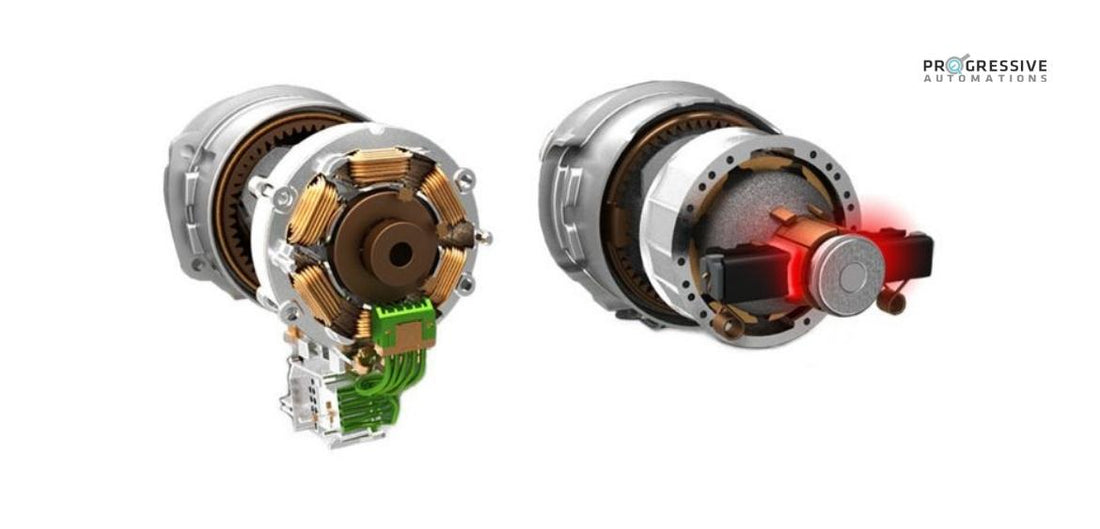The main difference is that a brushed motor uses physical brushes and a commutator to deliver electrical current to the motor windings, while a brushless motor (BLDC) uses electronic controllers instead of brushes to switch electrical current within the windings. For brushed motors, the design is simple, cost-effective, and provides good torque at low speeds, but it causes friction and wear over time, requiring regular maintenance. Brushless motors are more complex for integration but will eliminate friction, resulting in higher efficiency, longer lifespan, quieter operation, and less maintenance.
| Feature | Brushed Motor | Brushless Motor |
|---|---|---|
| Efficiency | Medium | High |
| Lifespan | Short, due to brush wear | Long, as there are no brushes to wear out |
| Performance | Medium speed, high startup torque | Higher speed |
| Noise | Noisy due to brush friction | Quiet, due to a lack of friction |
| Cost | Lower upfront cost | Higher upfront cost from complex control circuits |
| Complexity | Simple, can be controlled with rocker switches or similar | Complex, requires an electronic controller |
Browse all of our electric linear actuators, ranging from micro to industrial!
Brushed DC Motor
A brushed DC motor consists of a few main components which in conjunction with a DC power supply create a rotating motor. The armature, commutator, brushes, and field magnet configuration can be seen in Figure 1 below.

Figure 1: Drawing (left) and actual example (right) of Brushed DC motors
Our drawing shows a simplified armature for an easier view of the current flowing through; however, brushed DC motors will have multiple coil windings with their armature. The brushes charge the commutator which delivers current through the armature in the opposite polarity of the permanent magnet. This causes the armature to rotate from the attraction of the magnets.
Brushed DC motors are easy to operate since they are among the simplest types of motors, however, they will have a shorter lifespan compared to brushless motors. Due to the brushes making physical contact with the commutator, sparking is a common issue with brushed motors. This physical contact also wears out the brushes over time and result in some energy loss from the friction generated.
Choose the right control system for your actuator from our large selection!
Brushless DC Motor Controller
A brushless DC motor (BLDC) eliminates the major inefficiencies of its brushed counterpart. The motor is comprised of permanent magnets and coils, which through a series of perfectly timed energizing intervals cause the permanent magnet in the center to rotate around the coils that are surrounding it. We have included a brushless motor diagram for reference in Figure 2 below.

Figure 2: Drawing (left) and actual example (right) of Brushless DC motors
The coils in the brushless motor are energized in a specific sequence (Figure 3), which causes the permanent magnets on the rotor to rotate. This is done without any physical contact and allows for a more efficient, longer-lasting DC motor.

Figure 3: Coil energizing sequence
To follow the output shown in Figure 3, the brushless DC motor requires an Electronic Controller Unit (ECU), to determine the position of the rotor and which coils to energize.
Unlike the brushed DC motors which require 12VDC applied directly across the motor to rotate, the brushless DC motor requires 3 phase power. This means that a Brushless DC Motor controller must output the appropriate power to the different coils to achieve rotation. When using our LC-241 Brushless DC Motor Controller, 12VDC at 5A can be applied to the input terminals using a power supply. This is then converted to 3 phase power to control our brushless custom motors. In the next section, a basic wiring diagram will assist in testing a brushless DC actuator.
Wiring Brushless Motors to Rocker Switches
Progressive Automations offers the PA-14 Mini Linear Actuator in the Brushless DC option for custom orders. Our wiring schematic for Brushless PA-14 actuators can be seen in Figure 4 below.

Figure 4: Wiring schematic for Brushless PA-14 actuator
Step 1
Connect the 3 motor controller wires from the PA-14 Brushless Actuator to the LC-241 Brushless DC Motor Controller. The wires are typically green, blue, and white, which will connect to the U, V, and W terminals respectively. Ensure the brushless motor connections are tightly secured. If the wires are different colors, connecting them in the wrong order will simply move the electric linear actuator in the opposite direction than intended.
Step 2
Connect the SPD pin to the Ground of your 12 VDC power source to engage the built-in potentiometer for speed control. Make sure that this potentiometer is rotated clockwise for full speed.
Step 3
Connect the GND pin to the Common pins on your rocker switch.
Step 4
Connect the RUN pin to both sides of the rocker switch. This is important as both forward and reverse need the RUN pin making contact to Ground to function.
Step 5
Connect the REV pin to one side of the rocker switch. This side will be the reverse direction side of the rocker switch.
Step 6
Apply 12VDC to the brushless DC motor controller, an indicator noise can be heard on initial power-up.

Figure 5: Physical wiring of the brushless PA-14 actuator
The basic set up is now complete; using the rocker switch, the actuator can be extended and retracted. The issue with a brushless DC motor actuator is that the internal limit switches are not able to stop the power to the actuator like how it does for brushed DC motors. This is because the power going into the PA-14 Brushless Motor is 3 phase power. The PA-14 Brushless electric actuator comes with built-in limit switch feedback which can be utilized with a PLC or microcontroller to indicate that the actuator is at end of travel. The feedback acts as a Normally Closed to Normally Open switch which is essential to integrating a PA-14 brushless actuator into real-world applications.
We also have an article on Continuously Extend & Retract An Actuator Stroke With A Brushless DC Motor for reference with coding examples.
The new and improved PA-01 mini actuator (PA-14 upgrade) is the current model we offer with a variety of added benefits. For a comparison, check out the tables below and upgrade with confidence!
|
|
PA-01 |
PA-14 |
|
Dynamic Load Options |
16, 28, 56, 112, 169, 225 lbs |
35, 50, 75, 110, 150 lbs |
|
Highest Load |
225 lbs |
150 lbs |
|
Fastest Speed |
3.54 "/sec |
2.00"/sec |
|
Ingress Protection |
IP65 |
IP54 |
|
Stroke Options |
1" to 40" |
1" to 40" |
|
Hall Effect Feedback |
Optional |
No |
Wiring Brushed Motors to Rocker Switches
Most of our electric linear actuators come off the shelf with brushed DC motors. The easy operation of brushed DC motors allow for a rocker switches to be wired in between the DC power supply and brushed motor without any additional controller required.

Figure 6: Wiring schematic of a rocker switch to an actuator with brushed motor
The linear actuator wiring diagram above can be achieved by following a few steps:
- The upper-left and lower-right terminals must be connected to the ground of the power supply.
- The upper-right and lower-left terminals must be connected to the +12V terminal of the power supply.
- The middle-right and middle-left terminals must be connected to the 2 inputs from the actuator.
This type of actuator switch wiring allows their operator to change the direction of electrical current flow entering the actuator in order to change travel direction. For a physical example of an actuator wiring circuit with a rocker switch, this video is a great example.

Figure 7: Physical wiring of a rocker switch to an actuator with brushed motor
Want to introduce automation into your home? Take a look at our Home Automation products!
What is the main difference between brushed and brushless DC motors?
Brushed motors use carbon brushes and a commutator to deliver current to the motor windings, while brushless DC (BLDC) motors use electronic controllers to switch current. Brushed motors are simpler, more cost-effective, and provide good torque at low speeds, while brushless motors have higher efficiency, longer lifespan, and quieter operation.
Which type of motor is better for long-term use — brushed or brushless?
Brushless motors are better for long-term use because they have no brushes to wear out. This reduces friction, heat, and maintenance needs, allowing for significantly longer operational life compared to brushed motors.
What are the main advantages of brushless DC motors?
Brushless DC motors offer higher efficiency, longer lifespan, quieter performance, and improved speed and torque control. They also generate less heat and require little to no maintenance, making them ideal for continuous or precision applications.
What are the disadvantages of brushless motors compared to brushed ones?
The main disadvantages of brushless motors are the higher upfront cost and the need for an electronic controller. This makes them more complex and more expensive to install than brushed motors, which are simpler and cheaper for basic applications with non-continuous cycles.
Do brushless motors really last longer?
Yes. Because they don’t have brushes that wear down through friction, brushless motors can last longer than brushed motors, especially in continuous or high-duty applications.
Are brushless motors more efficient or powerful than brushed?
Brushless motors are more efficient because they waste less energy as heat and maintain consistent torque output. While both types can deliver strong performance, brushless designs provide better power-to-weight ratios and smoother operation overall.
Is a brushless motor worth the higher cost?
In most cases, yes. The higher upfront cost is offset by reduced maintenance, greater energy efficiency, and longer lifespan, which lowers the total cost of ownership over time.
Do brushless motors require less maintenance?
Yes. Since there are no brushes or commutators to replace, brushless motors require minimal maintenance — typically only periodic cleaning or inspection for dust and debris.
Can a brushless motor overheat, and how can it be prevented?
Brushless motors can overheat from electrical causes if overloaded or poorly ventilated so that heat from the electrical current cannot escape, but this is less common than in brushed motors, which can overheat from both mechanical and electrical causes. Overheating can be prevented by using a suitable force rating and a properly rated motor controller and ensuring adequate airflow.
Which type of motor is best for linear actuators and automation systems?
Brushless DC motors are generally the best choice for linear actuators and automation systems. They deliver smoother motion, higher efficiency, and longer service life — all crucial for precise, continuous, or high-duty applications. Brushed motors, however, remain a good option for simple or low-cost applications where short operation cycles are expected.
In Summary
Brushed DC motors have coils in their center rotating around permanent magnets while brushless DC motors have permanent magnet in the center that rotate around the coils. The brushless motor design is better suited for applications that will make use of its longer lifespan and greater energy efficiency. For a simpler and easier operation, applications with short cycle times can take advantage of the user-friendly design found in brushed DC motors.
If you have any queries or wish to discuss our products further, please do not hesitate in reaching out to us! We are experts in what we do and want to ensure you find the best solution for your application.
sales@progressiveautomations.com | 1-800-676-6123




